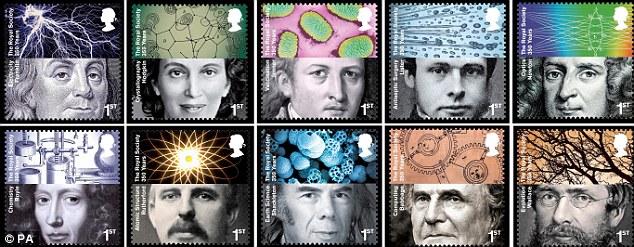Alfred Russel Wallace will at long last be featured on a Royal Mail stamp! His friend and colleague Darwin has of course appeared on countless stamps (most of which were published this year), but Wallace, the co-discoverer of evolution by natural selection, has only once been featured on a set of stamps and that was issued by a country he never even visited (to see these stamps CLICK HERE)!
The new Wallace stamp will be issued on the 25th February 2010. It was produced to celebrate the 350th anniversary of the Royal Society - a great honour indeed, especially considering that Darwin wasn't selected! Wallace was made a (reluctant!) Fellow of the Royal Society in 1893 and was awarded their prestigious Copley, Darwin and Royal Medals for his scientific achievements.
The stamp will feature a 'split design', with an image of Wallace below the image of an oak tree. Many months ago the designers contacted me to ask my opinion of their prototype design - which featured an ammonite fossil above Wallace's portrait. I told them that Wallace didn't really have much to do with fossils and that they might consider a gnarled leafless oak tree instead, as this would symbolise the great tree of life. Wallace was, of course, the first modern evolutionist to publish the tree of life analogy. In his famous 1855 'Sarawak Law' paper (see http://people.wku.edu/charles.smith/S020.htm) he says that the relationships between species are "...a complicated branching of the lines of affinity, as intricate as the twigs of a gnarled oak or the vascular system of the human body. Again, if we consider that we have only fragments of this vast system, the stem and main branches being represented by extinct species of which we have no knowledge, while a vast mass of limbs and boughs and minute twigs and scattered leaves is what we have to place in order, and determine the true position each originally occupied with regard to the others, the whole difficulty of the true Natural System of classification becomes apparent to us."

Here is the Royal Mail Press Release which mentions the Wallace stamp:-
'BRAINSTORMING’ SCIENCE STAMPS MARK ROYAL SOCIETY’S 350TH ANNIVERSARY
News Release
PON
2 December 2009
Royal Mail is set to issue a radical split-stamp design to celebrate the 350th anniversary of The Royal Society, the world's oldest scientific academy in continuous existence. The ten 1st Class stamps, issued on 25 February, feature ten significant Royal Society figures whose portraits are paired with dramatic and colourful imagery representing their achievements. The 'brainstorming' design was the idea of Hat-trick Design, responsible for the interlocking 'jigsaw' approach used for 2009's Darwin stamps. But with more than 1,400 Fellows and Foreign Members to choose from, how were ten significant scientific figures to be selected? Fittingly, it was The Royal Society itself which suggested the solution: a case of basic division. It was agreed to split the 350-year history into ten 35-year 'blocks' in which it could be demonstrated how, through the work of its Fellows, The Royal Society has had a major impact on the World. Royal Mail consulted with experts from the Society to determine the ten Fellows, and due to the global nature of the organisation, non UK citizens were included, such as one of the United States' Founding Fathers, Benjamin Franklin, and the New Zealand-born physicist Ernest Rutherford.
Julietta Edgar, Head of Special Stamps, Royal Mail said: "It has traditionally been a challenge for designers to seek innovative ways to feature an individual and 'tell their story' at the same time. "The contrast of black and white portraits and eye-catching use of scientific imagery has resulted in a spectacular and thought-provoking design." Ends
Issued by Aawaz Communications on behalf of Royal Mail Tel 020 7404 6064 Email: khollingsworth@aawazltd.com
NOTES TO EDITORS
Founded in 1660, The Royal Society celebrates its 350th anniversary in 2010 and as the national academy of science of the UK and the Commonwealth. It maintains its position at the forefront of enquiry and discovery, and at the cutting edge of scientific progress. The backbone of the Society, which is a charitable body, is its Fellowship of the most eminent scientists of the day, and there are currently more than 60 Nobel Laureates amongst the Society's Fellows and Foreign Members, of which there are more than 1,400.
To this day, Fellowship of The Royal Society is one the greatest honours that can be conferred on any scientist.
The Royal Society still supports many top young scientists, engineers and technologists, and continues to influence science policy and stimulating debate on scientific issues with the public.
Images of the Royal Society stamps and biographies of those featured on them are available by telephoning Kathryn Hollingsworth at Aawaz Communications on 0207 404 6064 or via e-mail from khollingsworth@aawazltd.com
Stamps and stamp products are available at all Post Offices, or online at www.royalmail.com/stamps and from Royal Mail Tallents House (tel. 08457 641 641), 21 South Gyle Crescent, Edinburgh, EH12 9PB.
The Royal Society Stamps
| Value |
Description |
| 1st - First Class inland letter Rate |
Robert Boyle – Chemistry |
| 1st - First Class inland letter Rate |
Sir Isaac Newton – Optics |
| 1st - First Class inland letter Rate |
Benjamin Franklin – Electricity |
| 1st - First Class inland letter Rate |
Edward Jenner – Vaccination |
| 1st - First Class inland letter Rate |
Charles Babbage - Computing |
| 1st - First Class inland letter Rate |
Alfred Russel Wallace - Evolution |
| 1st - First Class inland letter Rate |
Sir Joseph Lister – Antiseptic Surgery |
| 1st - First Class inland letter Rate |
Ernest Rutherford – Atomic Structure |
| 1st - First Class inland letter Rate |
Dorothy Hodgkin - Crystallography |
| 1st - First Class inland letter Rate |
Sir Nicholas Shackleton – Earth Science |
Royal Society Stamps – Technical Details
| Feature | Type/Detail |
| Number of stamps | Ten |
| Design | Hat-trick Design |
| Acknowledgements | Robert Boyle drawing and portrait, crystallography pattern © The Royal Society; colour spectrum, smallpox vaccination, Edward Jenner portrait, Ernest Rutherford portrait © Science Photo Library; Isaac Newton diagram and portrait, Charles Babbage diagram and portrait, Dorothy Hodgkin portrait © Science Museum/SSPL; lightning and Benjamin Franklin portrait © Getty Images; Alfred Russel Wallace portrait © National Portrait Gallery, London; oak tree photographed by Paul Grundy; Joseph Lister portrait © Wellcome Library, London; spray photographed by John Ross; atom © iStockphoto; micro-fossil image © SEPM Society for Sedimentary Geology, photographed by Dr Stanley A King; Nicholas Shackleton portrait courtesy of Ingrid Pearson |
| Stamp Format | Square |
| Stamp Size | 35mm x 35mm |
| Printer |
Cartor Security Printing |
| Print Process | lithography |
| Number per Sheet | 30/60 |
| Perforations | 14.5 x 14.5 |
| Phosphor | All Over |
| Gum | PVA |
Thanks to Michael Barton for the heads-up about this Press Release!

Add new comment